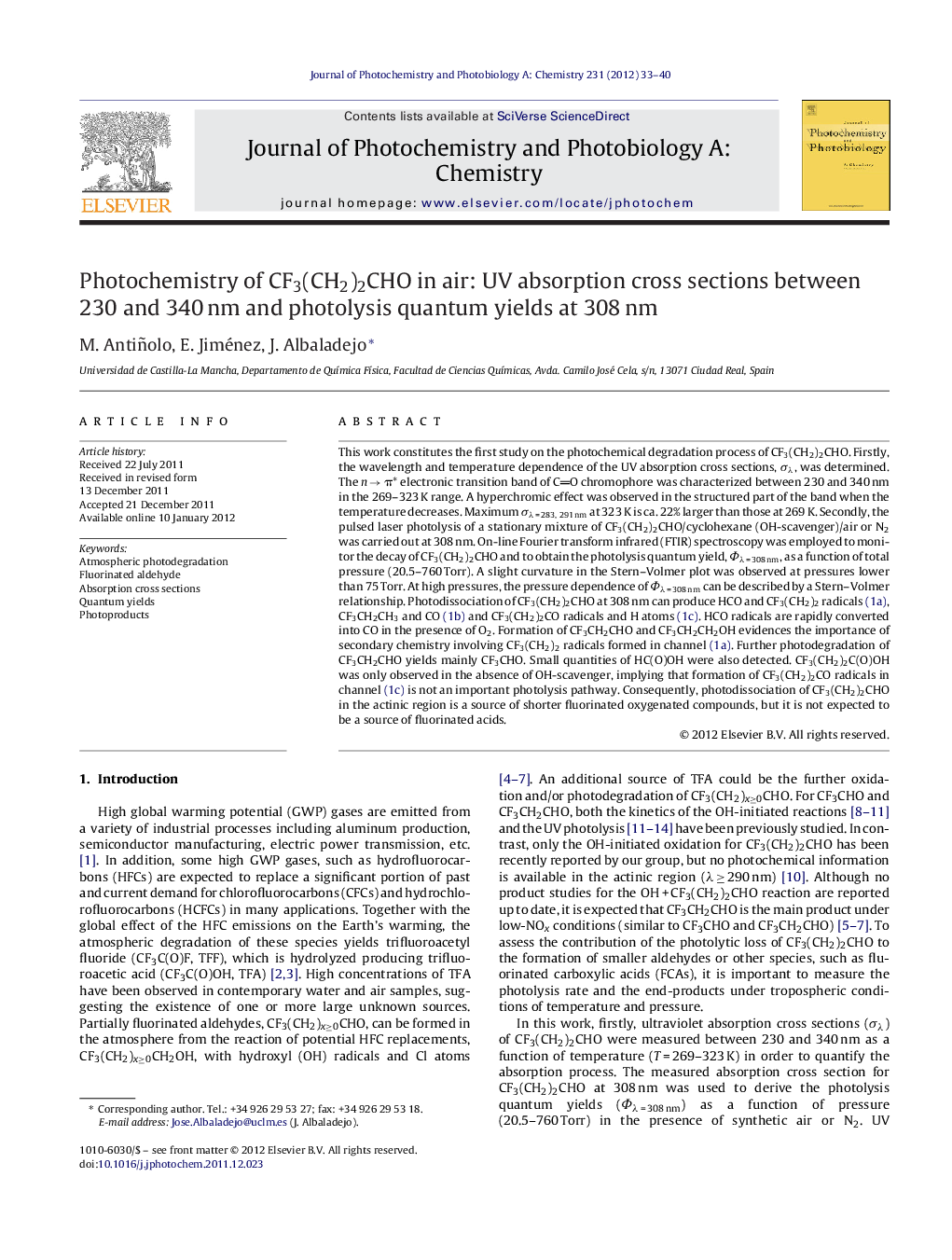| کد مقاله | کد نشریه | سال انتشار | مقاله انگلیسی | نسخه تمام متن |
|---|---|---|---|---|
| 27268 | 44013 | 2012 | 8 صفحه PDF | دانلود رایگان |

This work constitutes the first study on the photochemical degradation process of CF3(CH2)2CHO. Firstly, the wavelength and temperature dependence of the UV absorption cross sections, σλ, was determined. The n → π* electronic transition band of CO chromophore was characterized between 230 and 340 nm in the 269–323 K range. A hyperchromic effect was observed in the structured part of the band when the temperature decreases. Maximum σλ = 283, 291 nm at 323 K is ca. 22% larger than those at 269 K. Secondly, the pulsed laser photolysis of a stationary mixture of CF3(CH2)2CHO/cyclohexane (OH-scavenger)/air or N2 was carried out at 308 nm. On-line Fourier transform infrared (FTIR) spectroscopy was employed to monitor the decay of CF3(CH2)2CHO and to obtain the photolysis quantum yield, Φλ = 308 nm, as a function of total pressure (20.5–760 Torr). A slight curvature in the Stern–Volmer plot was observed at pressures lower than 75 Torr. At high pressures, the pressure dependence of Φλ = 308 nm can be described by a Stern–Volmer relationship. Photodissociation of CF3(CH2)2CHO at 308 nm can produce HCO and CF3(CH2)2 radicals (1a), CF3CH2CH3 and CO (1b) and CF3(CH2)2CO radicals and H atoms (1c). HCO radicals are rapidly converted into CO in the presence of O2. Formation of CF3CH2CHO and CF3CH2CH2OH evidences the importance of secondary chemistry involving CF3(CH2)2 radicals formed in channel (1a). Further photodegradation of CF3CH2CHO yields mainly CF3CHO. Small quantities of HC(O)OH were also detected. CF3(CH2)2C(O)OH was only observed in the absence of OH-scavenger, implying that formation of CF3(CH2)2CO radicals in channel (1c) is not an important photolysis pathway. Consequently, photodissociation of CF3(CH2)2CHO in the actinic region is a source of shorter fluorinated oxygenated compounds, but it is not expected to be a source of fluorinated acids.
► First photochemical study on CF3(CH2)2CHO in air: absorption cross sections, photolysis quantum yields and degradation products.
► Absorption cross sections of CF3(CH2)2CHO are determined as a function of wavelength (230–340 nm) and temperature (269–323 K).
► Photolysis quantum yields of CF3(CH2)2CHO strongly depend with pressure, varying from 0.1 to 0.5 (760 and 75 Torr, respectively).
► Photodissociation of CF3(CH2)2CHO at 308 nm mainly produces HCO and CF3(CH2)2 radicals, which finally form CO, CF3CH2CH2OH, and CF3CH2CHO.
Journal: Journal of Photochemistry and Photobiology A: Chemistry - Volume 231, Issue 1, 1 March 2012, Pages 33–40